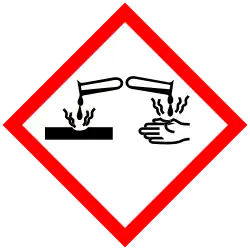Ethylcyclohexane
 | |
| Identifiers | |
|---|---|
3D model (JSmol)
|
|
| ChEBI | |
| ChEMBL | |
| ChemSpider | |
| ECHA InfoCard | 100.015.305 |
| EC Number |
|
PubChem CID
|
|
| UNII | |
| UN number | 1993 |
CompTox Dashboard (EPA)
|
|
| |
| |
| Properties | |
| C8H16 | |
| Molar mass | 112.216 g·mol−1 |
| Appearance | colorless liquid |
| Density | 0.788 g/cm3 |
| Melting point | −111.3 °C (−168.3 °F; 161.8 K) |
| Boiling point | 130–132 °C (266–270 °F; 403–405 K) |
| Hazards | |
| GHS labelling:[1] | |
  
| |
| Danger | |
| H225, H304, H336 | |
| P210, P233, P240, P241, P242, P243, P261, P271, P280, P301+P316, P303+P361+P353, P304+P340, P319, P331, P370+P378, P403+P233, P403+P235, P405, P501 | |
| Flash point | 35 °C; 95 °F; 308 K |
| 238 °C; 460 °F; 511 K | |
Except where otherwise noted, data are given for materials in their standard state (at 25 °C [77 °F], 100 kPa).
Infobox references
| |
Ethylcyclohexane is an organic compound with the formula C6H11C2H5. The molecule consists of an ethyl group attached to a cyclohexane ring. It is a typical naphthene in petroleum. It can be produced by hydrogenation of ethylbenzene and by hydrodeoxygenation of lignin.[2]
References
- ^ "Ethylcyclohexane". pubchem.ncbi.nlm.nih.gov.
- ^ Zhao, Chen; He, Jiayue; Lemonidou, Angeliki A.; Li, Xuebing; Lercher, Johannes A. (2011). "Aqueous-phase hydrodeoxygenation of bio-derived phenols to cycloalkanes". Journal of Catalysis. 280: 8–16. doi:10.1016/j.jcat.2011.02.001.